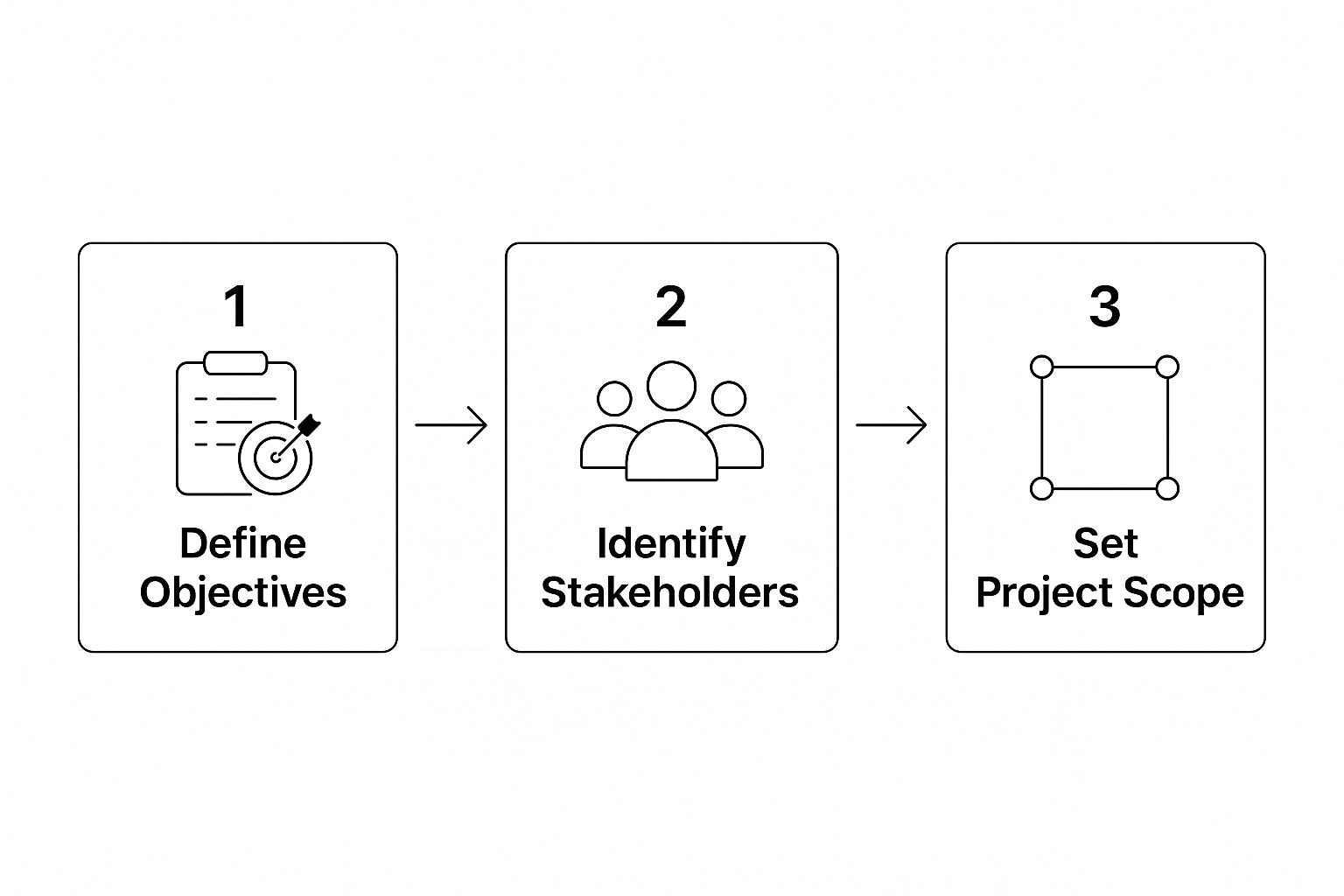Trying to write project requirements can feel like you're just ticking a box, but it's so much more than that. This is the bedrock of your entire project.
Get it wrong, and you’re basically operating on guesswork. That’s a fast track to endless rework, blown budgets, and deadlines that fly by. Honestly, poorly defined requirements are one of the biggest reasons projects fail, which makes this first step absolutely critical.
A solid requirements document is your single source of truth. It's what keeps everyone on the same page.
It draws a clear line in the sand, defining what’s in scope and, just as importantly, what’s out. This document becomes the roadmap for your design and development teams and gives you something concrete to test against when you think you're done.
The real goal here is to turn big, fuzzy business goals into specific, actionable items that leave zero room for misinterpretation. Nailing this down at the start has a massive impact on the key factors for project success and makes sure you actually deliver something valuable.
Setting The Stage For Success
Before you even think about writing a single requirement, you need to get your foundation right. I've seen too many teams jump straight into the details without laying the groundwork first.
This flowchart breaks down the three essential things you have to do before you start writing.

It’s simple but powerful: define your objectives, figure out who your stakeholders are, and then set the scope. You have to do them in that order. Skipping ahead is a classic mistake that almost always leads to chaos down the road.
There’s a reason skilled project managers are in such high demand. The global economy is projected to need a staggering 87.7 million people in project management roles by 2027. This explosion in complex work means that getting requirements right isn't just a "nice to have"—it's a core competency.
To help you get started, here's a simple checklist that breaks down the process.
Project Requirements Checklist
This table maps out the key phases, what you need to do in each one, and what a successful outcome looks like. It’s a great way to keep yourself on track.
| Phase | Action | Outcome |
|---|---|---|
| Discovery | Conduct stakeholder interviews and initial research. | A clear understanding of the core business problem and high-level goals. |
| Definition | Translate stakeholder needs into specific, measurable statements. | A prioritized list of functional and non-functional requirements. |
| Documentation | Organize requirements into a structured document (e.g., PRD or BRD). | A single source of truth that is accessible to the entire team. |
| Validation | Review the draft with all key stakeholders for feedback and approval. | Signed-off requirements that provide a stable baseline for development. |
Think of this as your game plan. Following these steps helps ensure that by the time you're ready to build, everyone is aligned and working toward the same clear, well-defined goal.
Gathering Essential Project Information

A solid requirements document is built on high-quality information. But if your process is just asking stakeholders, "So, what do you want?" you're setting yourself up for failure. That question is an open invitation for vague wishes, conflicting ideas, and a ton of hidden assumptions that will absolutely derail your project down the line.
To get this right, you have to dig deeper.
Think of it less like taking notes and more like investigative journalism. Your job is to facilitate discovery, using targeted techniques to uncover not just what people say they need, but the unspoken context that’s actually driving the project.
Moving Beyond Basic Questions
Forget the single, generic Q&A session. A much better approach is to plan a series of focused conversations, because each method unlocks a different piece of the puzzle. When you combine them, you start to see the whole picture.
Here are a few techniques I’ve found incredibly effective:
- Structured Interviews: Don't ask everyone the same thing. Tailor your questions. An executive’s view on business drivers is worlds away from an end-user's daily frustrations. Use open-ended questions that encourage people to tell stories.
- Empathy Mapping Sessions: Get your team in a room for a collaborative workshop. Map out what a specific user persona sees, hears, thinks, and feels. This is a game-changer for digging into the emotional drivers and frustrations that a simple survey will always miss.
- Direct Observation: Go watch users do their jobs in their own environment. Seriously. This "show, don't tell" approach is pure gold. You’ll spot workarounds and pain points that users have gotten so used to, they wouldn't even think to mention them.
On a recent CRM rollout I managed, we spent a full day in a workshop with a massive whiteboard. We listed every "wish" from stakeholders on one side. On the other, we mapped each wish back to a core business goal. This one simple exercise helped us slash potential scope creep by over 30% because it made the distinction between "wants" and "needs" crystal clear.
Documenting and Organizing Your Findings
As the information pours in, documentation is your best friend. But please, don’t just keep a running list of random notes. You need to organize your findings into meaningful clusters that you can actually use. For a deeper look at this crucial discovery phase, check out our guide on how to conduct user research.
Put on your investigator hat. Every interview transcript, workshop photo, and observation note is a piece of evidence. Label everything—who said it, when, and in what context. This traceability is invaluable later when you need to validate a requirement or, let’s be honest, settle a debate.
Ultimately, your goal here is to build a rich repository of insights before you even think about writing the formal requirements document. By separating discovery from documentation, you ensure that what you finally write is grounded in a deep, shared understanding of the real problem you're all trying to solve.
Structuring A Clear Requirements Document

So, you’ve done the hard work of gathering insights from every stakeholder you could find. Awesome. Now comes the real challenge: turning that mountain of raw data into a living document everyone can actually use. A jumble of notes and requests just won't cut it.
The difference between a useful guide and a document that collects digital dust is structure. Your goal here is to create a single source of truth that’s logical, easy to navigate, and crystal clear for everyone involved—from the C-suite to the engineering team.
A well-organized document is more than just tidy; it's an actionable blueprint that prevents crucial details from slipping through the cracks. It’s how you get everyone on the same page and keep them there.
Start With The Big Picture
Before you even think about listing out features, you have to set the stage. A strong introduction is everything. It frames the entire document and ensures anyone who picks it up immediately understands the "why" behind the project.
Kick things off with a concise executive summary. This is your 30,000-foot view of the project's purpose, how it ties back to the company's bigger goals, and the core problem you're setting out to solve. It gets everyone grounded in the same mission from page one.
Right after that, you need a rock-solid scope statement. This might be the most critical piece of the entire document. If you want to see a great one in action, you can check out this detailed sample project scope document for a complete walkthrough.
Your scope statement has to be ruthless. It must explicitly define what is in the project and—just as importantly—what is out. This one section is your best defense against scope creep down the line.
Humanize The Requirements
A long list of technical specs can feel sterile and disconnected from the people who will actually use the product. You need to bridge that gap by bringing the user's voice directly into the document. Doing this helps the development team truly understand the human impact of their work.
Here’s how you can do that:
- Introduce User Personas: Build out a few fictional but totally realistic profiles of your key users. Give them names, goals, motivations, and pain points.
- Include User Journey Maps: Visualize the exact steps a user takes to get something done with your product. This is a fantastic way to spot friction points and uncover opportunities you might have missed.
These aren't just fluffy additions; they are powerful tools for building empathy. When an engineer knows who they're building for and why a certain feature matters to that person, they make better, more thoughtful decisions. It’s that simple.
Classify And Organize The Details
Okay, with the high-level context set, you can finally dive into the nitty-gritty. The most effective way to wrangle all your specific requirements is to sort them into logical categories. This makes the document infinitely easier to navigate and review, and it stops things from getting messy.
Think of it like this: every requirement has a different job to do. To help you sort them out, I've put together a quick breakdown of the common types. Use this as your guide to classify every item on your list, making sure each one finds its proper home in your document.
Types of Project Requirements Explained
| Requirement Type | Definition | Example |
|---|---|---|
| Functional | Describes what the system must do. These are the features and actions a user will directly interact with. | "The system shall allow users to reset their password via a secure email link." |
| Non-Functional | Defines how the system should perform. This covers things like speed, security, and overall reliability. | "The password reset page must load in under 2 seconds on a standard internet connection." |
| Technical | Specifies any technical constraints or rules the system must follow, which are often invisible to the end user. | "The application must be developed using the React framework and deployed on AWS." |
| Business | High-level goals of the organization that the project is meant to achieve. These are the "why" from the business side. | "Reduce customer support calls related to password issues by 25% within six months of launch." |
By breaking your requirements down this way, you're not just creating a list; you're creating a clear, comprehensive, and organized map that the entire team can follow from kickoff to launch.
Writing Unambiguous And Testable Requirements
Once you have a structured document, the real work begins. It's time to craft requirements that are impossible to misinterpret. This is exactly where so many projects go completely off the rails, buried under a mountain of vague, subjective language that means different things to different people.
Your ultimate goal here is clarity. Absolute, undeniable clarity.
Ambiguity is the enemy of progress. I'm talking about phrases like "user-friendly," "fast," or "robust." These are project killers because you can't measure them. Learning how to write effective project requirements means replacing these empty words with concrete, testable statements that leave zero room for guesswork.
Don't underestimate the damage here. Poorly defined requirements are a massive driver of project failure—nearly 10% of every dollar invested is wasted due to poor project performance. And what’s wild is that only about 23% of organizations actually use dedicated software to manage their requirements. That’s a huge gap in process.
Adopt Proven Frameworks For Clarity
You don't need to reinvent the wheel to eliminate ambiguity. A couple of powerful frameworks, SMART and INVEST, give you a reliable blueprint for turning fuzzy ideas into actionable requirements. These aren't just buzzy acronyms; they are practical filters you should run every single statement through.
The SMART framework is fantastic for setting clear, measurable goals:
- Specific: What exactly needs to be done? Who is this for?
- Measurable: How will we know when it’s finished? What are the metrics for success?
- Achievable: Is this actually realistic given our time, budget, and resources?
- Relevant: Does this requirement align with the bigger business objectives?
- Time-bound: What's the deadline?
Applying these criteria forces you to add a level of detail that shuts down misunderstandings before they can even start. If you want to really sharpen your skills here, check out these expert tips on writing better specifications as a PM.
On one SaaS project I led, our initial backlog was a mess of vague user stories. We went back and rewrote over 60% of them using these frameworks, and the result was a 40% drop in QA rework. Just defining what "done" meant upfront saved us weeks of painful back-and-forth.
Make Every Requirement Testable
A requirement isn't truly complete until you know how to prove it works. This is where acceptance criteria come into play. These are the specific, pass/fail conditions that must be met for a requirement to be marked as "done."
Think of it this way: the requirement is the goal, and the acceptance criteria are the rules of the game. They give your developers a clear checklist to build against and your QA team a clear script to test against.
For example, a horribly written requirement might be: "Users should be able to log in easily."
Here’s what a testable, well-defined version looks like:
- Requirement: As a registered user, I want to log into my account so I can access my dashboard.
- Acceptance Criteria:
- The login form must include fields for email and password.
- Successful login redirects the user to their dashboard within 2 seconds.
- An incorrect password displays the error message: "Invalid credentials. Please try again."
- The "Forgot Password" link is clearly visible on the login page.
See the difference? This level of detail removes all ambiguity. The dev team knows exactly what to build, and the testing team knows exactly what to validate. Connecting these clear criteria to tangible outcomes is fundamental, and it's a huge factor in how to measure project success.
Adapting Requirements For Global Projects

When your project crosses borders, a single, rigid set of requirements is practically a guarantee for failure. It's a different ballgame. Global teams are juggling a unique mix of cultural norms, local laws, and completely different levels of market maturity—all of which have a direct impact on project priorities.
Brushing past these local nuances isn't just a small oversight; it can send your entire project off the rails.
What flies in one region might be totally irrelevant—or worse, illegal—in another. Think about a data-heavy project: in Europe, you’d better have explicit privacy controls baked in from day one to meet strict GDPR standards. But if you're launching a similar project in the Asia-Pacific market, the bigger priority might be optimizing for mobile use in low-bandwidth areas.
Integrating Local Realities Into Your Document
The real trick to writing project requirements for a global team is building flexibility right into the document itself. This means ditching the single, rigid list and adopting a more modular approach that actually acknowledges and respects those regional differences.
A great place to start is making local compliance checks a non-negotiable part of your process.
Here are a few practical ways to do this:
- Create Region-Specific Appendices: Keep your core requirements universal, but add dedicated sections that outline specific adjustments, regulations, or user expectations for each market.
- Use Bilingual Templates: If you're working with multilingual teams, providing bilingual templates can cut down on misunderstandings and bridge language gaps right from the start.
- Host Localized Workshops: Get feedback straight from your regional teams. They’re on the ground and are your best source of truth for what will actually work in their market.
A multinational retailer I consulted with completely synced up their requirements process by running these localized workshops. The result? They slashed translation errors and rework by a stunning 80% and launched features that actually resonated with local customers.
Navigating Different Project Management Cultures
It’s not just the market that’s different—it’s the people and processes, too. How project requirements are written, managed, and enforced can vary dramatically around the world.
For instance, North America is home to over 930,000 PMP-certified professionals who are trained to follow rigorous, standardized processes. Meanwhile, Europe is seeing 20% annual growth in project management roles, but teams there spend a ton of energy just navigating the legal minefield of GDPR.
And in the fast-growing Asia-Pacific market, a shortage of skilled project managers often means the initial requirements can lack the detail needed. You can discover more project management insights and worldwide trends to get a better handle on these differences.
Ultimately, successful global projects are all about balance. You need a centralized strategy to keep things consistent, but decentralized execution to let local teams adapt. By building regular cross-border reviews into your timeline and treating regional stakeholders as true partners, you ensure your project requirements reflect the reality of every team, not just the one at headquarters.
Common Problems And How To Fix Them
Even the most seasoned teams can hit a wall when it comes to writing project requirements. I’ve seen it happen time and time again—the same classic problems pop up, turning what should be a clear roadmap into a source of endless confusion and rework.
Recognizing these pitfalls early is everything. It's the difference between a smooth project and a painful one.
One of the biggest culprits is vague or ambiguous language. We’ve all seen it. Phrases like "improve user experience" or "make it more intuitive" sound great in a meeting but are completely untestable in reality. Without hard numbers to back them up, every single stakeholder will have their own definition of what "done" looks like. That’s a recipe for debate and disappointment down the line.
Another classic mistake is overlooking non-functional requirements. Teams get so laser-focused on what the system should do (the functional stuff) that they forget to define how well it should do it. This is how you end up with slow load times, glaring security holes, or a system that crashes the second you get a spike in traffic.
Proactive Fixes For Common Requirement Headaches
Instead of just reacting to these issues as they blow up your timeline, you can get ahead of them. The goal is to build a process that naturally surfaces and resolves ambiguity before it ever becomes a real problem.
A peer-review process is your best first line of defense. Seriously, don't write requirements in a silo. Get a draft in front of a developer, a QA analyst, and a business stakeholder. Their unique perspectives will poke holes in any fuzzy statements right away.
I managed an infrastructure project recently where we started a weekly 30-minute “requirements clinic.” It was just a short, focused meeting to hash out ambiguities. The result? Our late-stage change requests dropped by an incredible 70%.
Maintaining Alignment and Clarity
Conflicting demands from different stakeholders can also throw a project into chaos, pulling the team in a dozen different directions at once. This usually happens when requirements are gathered in separate, disconnected conversations. Suddenly, marketing’s "must-have" feature directly contradicts a hard constraint from the legal team, and everything grinds to a halt.
The simple fix here is a decision log. It’s just a document that tracks every key decision: what was decided, who made the call, and why. It becomes your single source of truth, preventing the team from having the same argument over and over. This kind of documentation is also a huge part of learning how to manage scope creep effectively.
Here are a few other practices I swear by:
- Create a Centralized Glossary: Define every key term and acronym in one shared space. This small step eliminates a surprising amount of confusion.
- Use Strict Version Control: Always, always track changes to your requirements doc. A clear version history shows what changed, when it changed, and who signed off on it.
- Hold Short Alignment Calls: Documents are great, but don't rely on them alone. Quick, regular check-ins make sure everyone is actually interpreting the requirements the same way.
By building these simple checks and balances into your process, you transform requirements gathering from a potential minefield into a solid foundation for the entire team.
Got Questions? I've Got Answers.
Even with the best guide in hand, you're going to have questions once you start getting into the weeds of writing requirements. It just happens. These are a few of the ones that I see pop up all the time, along with some straight-to-the-point answers to keep you moving.
Where Do I Even Begin With Writing Requirements?
Forget the document for a second. The real first step is getting the right people in a room.
Before you type a single word, you need to run a stakeholder alignment workshop. The whole point is to get every key player together—virtual or in-person—to hash out what the project is really about and agree on what a "win" actually looks like. This is where you nail down the big-picture business goals and uncover any constraints.
Skipping this is a classic mistake. Trust me. It almost always leads to conflicting priorities and a ton of wasted time down the road. Get everyone on the same page first, then start writing things down.
Who Needs to Read and Approve This Thing?
A requirements document isn't something you just write and toss over the fence. Think of it as a contract between all the teams involved. To make sure it's solid, you need a few different sets of eyes on it.
Your review crew should always include people from:
- The Business Side: They’ll make sure what you’ve written still lines up with the company's goals.
- Engineering/Development: They're your reality check for what’s technically possible and how much effort it’ll take.
- Quality Assurance (QA): If they can't figure out how to test it, it's not a good requirement. Period.
- Operations: These folks will spot any potential headaches for existing systems or daily workflows.
Getting a sign-off from this group confirms that the plan is comprehensive, achievable, and ready for action.
The biggest mistake you can make is treating the requirements doc like a simple hand-off. It’s a pact. Everyone with a stake in the outcome needs to read it, get it, and agree to it before a single line of code gets written.
How Do I Stop Scope Creep From Killing My Project?
Ah, scope creep. The silent killer of timelines and budgets. It's that slow, sneaky expansion of a project that happens one "small" request at a time. Your best defense? A formal change-control process.
This isn't about shutting down new ideas. It's about being smart about change.
Once your initial requirements are signed off, any new request has to go through a proper process. That means someone has to analyze its impact on the timeline, budget, and team, and then the original stakeholders have to formally approve it. This little bit of discipline ensures every change is a conscious decision, not a casual distraction.
What Are the Best Tools for Managing All This?
The right tool really depends on how complex your project is and how your team likes to work.
For most teams running agile, you can't go wrong with platforms like Jira and Confluence working together. It’s a fantastic combo for tracking user stories and keeping all your documentation in one living, breathing space. If you're in the Microsoft ecosystem, Azure DevOps offers a very similar, tightly integrated setup.
Now, if you're in a super complex or heavily regulated field—think aerospace or medical devices—you’ll probably be looking at specialized tools like IBM DOORS. These platforms are built for the intense traceability and version control you need to stay compliant.
At Creativize, we help businesses connect with incredible creative talent to turn well-defined projects into reality. When your requirements are ready, find the branding, design, and animation experts you need to get it done. Explore our network of creative professionals.

